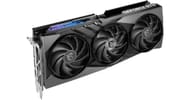The Nvidia RTX 50 series and the AMD Radeon RX 9000 series (which is what the RDNA 4 lineup is rumored to be named) are the talk of the town these days. Both of these GPU lineups are expected to be launched in early 2025, with rumors pointing to reveals at the CES event. This year's iteration of the electronics show is set for January 7-10 in Las Vegas.
We have already heard a lot about what to expect with the two upcoming generations, so gamers are naturally curious — which lineup would be better for gaming? This article looks at all the details and tries to answer this question.
Note: This article is primarily based on leaks, so readers are asked to take the information with a bit of salt.
What are the GPUs leaked to launch as part of the Nvidia RTX 50 series lineup?

The Nvidia RTX 50 series will likely share the DNA of the generations before it. Team Green is expected to go all-out with the flagship RTX 5090. The card has been rumored to bundle 32 GB of GDDR7 video memory and a whopping 21,760 CUDA cores. It has also been rumored to have an eye-watering 600W power draw budget, hinting at a serious performance upgrade over the last generation.
Other cards expected to launch alongside this giant are the 5080, the 5070 Ti, the 5070, and the 5060. Rumors are suggesting all of these GPUs might be launched by the first quarter of 2025 given Nvidia is already running three months behind schedule.
Rumors suggest that none of the cards would be receiving a significant specs overhaul as Nvidia targets to keep each card at its current market segment. However, the faster hardware likely powering each of them should make them perform better than the current-gen offerings, letting players get significant performance uplifts without paying more.
The rumored specs lists for each GPU are as follows:
In terms of pricing, recent leaks have hinted at a $2,600 RTX 5090 and a $999 5080. We don't have much information about the remaining cards as of yet and will update you once they are officially announced.
What are the GPUs leaked to launch as part of the AMD RX 9000 series lineup?
AMD is also expected to launch a host of Radeon RX 9000 series cards to rival the RTX 50 series GPUs. However, this time around, the company is supposedly taking some drastic decisions to stay relevant in the market. For starters, they might choose to completely ignore the 80-class or 90-class offerings. This is unlike the last two generations where high-end cards from Team Red gave Nvidia a run for its money.
The cards rumored as part of the RDNA 4 are as follows: the RX 9070 XT, the RX 9070, the RX 9060, the RX 9050, and the RX 9040. The cheaper variants could be launched at a later date if historic trends are anything to go by.
Besides dropping out of the flagship race, AMD might also consider a naming tweak, if you look at the GPU names closely. Unlike the last three generations, where the company followed the "xx00" naming pattern, and we got cards like the RX 7900 XT and the RX 6700 XT, Team Red might take up a more Nvidia-like name for their cards.
Although details about the underlying specs of these GPUs are still unknown, here's everything that has been leaked:
Nvidia vs AMD: Who might offer the better GPUs?

From the looks of it, Nvidia should comfortably retain the performance crown in the upcoming generation. Looking at older cards, the AMD RX 9070 XT might only be as fast as the RTX 5070/5070 Ti. If this were to happen, Nvidia could have two GPUs, the RTX 5080 and the 5090, that outperform all of the RDNA 4 lineup.
Given how Intel isn't very interested in launching a flagship Battlemage-based card, Nvidia's RTX 50 series should comfortably hold the performance trophy in the upcoming generation without much effort. However, the main battle will be fought in the mid-range and performance-per-dollar metrics. We already have gotten an early look at what competitors like Intel are planning: the $249 B580 recently took the budget gaming market by storm with its significant performance improvements.
Given how AMD is likely to refocus its entire RDNA 4 lineup on mid-range GPUs, we won't be surprised if the cards are designed to take out Nvidia's offerings in terms of pricing. Thus, the answer to the RTX 50 series vs. RX 9000 series question lies in the price point. While Nvidia looks set to be the winner when it comes to premium offerings, the mid-range might witness a closer battle.
Read more: AMD Radeon RX 7900 XT vs Nvidia RTX 4090
Why might AMD drop out of the flagship GPU race?
There could be multiple reasons why AMD might consider dropping out of the flagship GPU race.
For starters, AMD's high-end offerings, namely the RX 6900 XT and the RX 7900 XT lineups, haven't sold well and might have even caused the company to incur heavy losses. Given the significant lead Nvidia has in terms of exclusive hardware and performance numbers, this isn't a surprise.
This could be a solid reason for the company to consider dropping out of the high-end GPU market. By focusing on building smaller graphics chips from the get-go, AMD can naturally cut costs and make their graphics cards cheaper — a crucial factor in determining how their offerings would sell.
